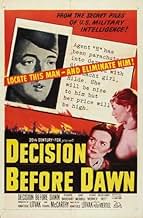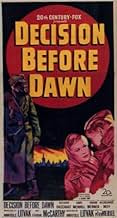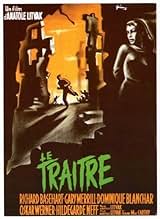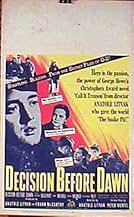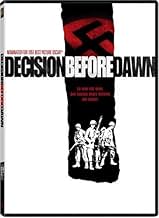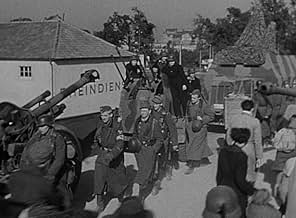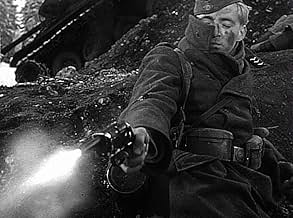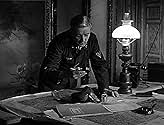PUNTUACIÓN EN IMDb
7,2/10
3,2 mil
TU PUNTUACIÓN
Añade un argumento en tu idiomaAs the US Army approaches Nazi Germany, they recruit German prisoners of war to spy behind German lines.As the US Army approaches Nazi Germany, they recruit German prisoners of war to spy behind German lines.As the US Army approaches Nazi Germany, they recruit German prisoners of war to spy behind German lines.
- Dirección
- Guión
- Reparto principal
- Nominado para 2 premios Óscar
- 1 premio y 4 nominaciones en total
Hildegard Knef
- Hilde
- (as Hildegarde Neff)
Wilfried Seyferth
- Heinz Scholtz - SS Man
- (as Wilfried Seyfert)
Robert Freitag
- Sgt. Paul Richter
- (as Robert Freytag)
Harold Benedict
- Lt. Pete Gevers
- (as H.L. Benedict S/Sgt. USAF)
H.W. Briggs
- Self
- (as H.W. Briggs Sgt. USA)
D.G. Devine
- Lt. Rennick's Driver
- (as D.G. Devine Cpl. USAF)
L.E. Dixon
- Self
- (as L.E. Dixon Maj. USA)
B.L. Hendrickson
- Self
- (as B.L. Hendrickson T/Sgt. USA)
Reseñas destacadas
Having served in the US Army-Europe in Germany it was easy to see that this work was an accurate depiction of the world as Germans saw it in those years. Going to the IMDb database confirmed that it was filmed in Wurzberg, a city I visited many times. One can not help but wonder what memories and nightmares came back to life for the German people in this movie, or the ones who viewed it, or even witnessed the movie being made. The film is so very realistic in script, acting, and setting that some must have almost thought WWII was alive again. For those that lived through WWII in that country it must have seemed as if those days were repeating themselves. Every detail of this movie is accurate as far as I could tell. It does not employ overused stereotypes, no action heroes, no earth shaking grand and glorious finale, it simply depicts a period of time in all its' tragedy and irony in a most realistic manner. This work deserves more praise and exposure than it has received. A must see for every WWII researcher and historian.
For anyone who is used to freedom, this movie shows better than any other what it is like to live in a total police state. The Thousand-Year Reich is shown with every wart and blemish, making this one of the greatest propaganda movies for freedom. But it is a harrowing experience, a true thriller. For the life of me, I cannot understand why this film is not better known and why it is hardly available in public libraries. Could this reflect the conservative, McCarthyite influence on movies? I think it is a must-see.
I have seen this film on cable several times. Some of the scenes that are supposed to be in Wurzburg are actually in Munich. The chase scene in the rubble towards the end of the film was near the old Bavarian "Rezidence" or Royal palace that the Wittelsbach family lived in near the old town area of Munich. I recognized the Kriegsmuseum building which is now the seat of the Bavarian state government. Other than that I really enjoyed the film. Having read countless stories about the demise of the once mighty Wehrmacht this film was, to me, accurate in its portrayal of soldiers beaten down and waiting for the inevitable end. Werner has been one of my favorite actors. His performances in "The Spy who came in from the Cold", "Fahrenheit 451" are very good.
Close to the end of WW2, the US military recruits Nazi defectors from the ranks of German POW's to return to Germany as spies. Klaus Kinski makes a brief appearance during the interview process, but his character is rejected. Who is accepted to participate in this mission is incomparable Oskar Werner as Corporal Karl Maurer who is given the code name Happy. It's an ironic name for such a serious actor. He's perfect for the part in this heavy film set largely in the destruction of bombed out cities. Such a setting makes it difficult for the Germans to actually capture him, as when they are on to his trail, the aerial Allied bombings begin again. There are lots of places to hide amidst the treacherous ruins of the near collapsing buildings.Yet the Germans try to maintain discipline to the very end, as a deserter is hanged and his body is left for all to see. The film uses the destruction in which it is set and reminds us of how things change when the peace time environment becomes lost amidst the destruction. Werner goes through several meetings with Germans, the best being the Colonel who orders the deserter to be hanged, and another with the tragic character played by Hildegard Knef, whom he meets in a bar. Amidst the desperation still lurks a couple of true Nazi believers, one played quite well by Wilfred Seyferth as Heinz Scholtz, a dangerous SS man who befriends the traitor Werner. The film is overwhelmingly stark and lacks any sense of humor whatsoever, but in my book that just adds to the overall effect, much like some of the Cold War era spy films, such as The Spy Who Came In From The Cold.
Surprisingly good war film unknown to me before I saw it on American Movie Classics. Cast is excellent. Characters are well-drawn. The film is the best portrayal I have yet seen on celluloid of Germany in its stages of final collapse as the end of WWII nears. Some very impressive interiors are beautifully shot - the cathedral that serves as intelligence hq, and the castle or chateau that is the German command hq. Engrossing story of conflicted loyalties, and good action and suspense as well. I can only add my agreement with the positive comments already entered.
¿Sabías que...?
- CuriosidadesOne of the first films after World War II to portray the German people--outside of the Nazi regime--in a sympathetic light.
- PifiasKarl is mistakenly called a corporal. The Luftwaffe uniform that he wears both in the US POW cage and while back in Germany has the rank insignia of an "Obergefreiter", specifically three winged emblems on the collar patches, plain shoulder straps and two chevrons on his left sleeve. Also when the list is checked for his name at the bridge the rank is written down as 'Gfr' (gefreiter) The ranks of Gefreiter, Obergefreiter and Stabsgefreiter (all which were partially identified by chevrons on the sleeve) were not NCOs and had no command authority over other soldiers. They were simply grades of seniority and would be more equivalent to Private First Class (PFC) in the US military. The German rank that is the closest equivalent to Corporal is Unteroffizer. Also, Karl is wearing the medical badge on his right sleeve; Luftwaffe enlisted medical personnel wore the badge on the left sleeve, while Wehrmacht (army) wore it on the right.
- Citas
Lt. Dick Rennick: [Intro narration] Of all the questions left unanswered by the last war, and probably any war, one comes back constantly to my mind. Why does a spy risk his life... for what possible reason? If the spy wins, he's ignored. If he loses, he's shot.
- ConexionesReferenced in Esa chica: Decision Before Dawn (1968)
- Banda sonoraAch, wie ist' möglich dann (Treue Liebe)
(uncredited)
Written by Friedrich Kücken (1827)
Selecciones populares
Inicia sesión para calificar y añadir a tu lista para recibir recomendaciones personalizadas
- How long is Decision Before Dawn?Con tecnología de Alexa
Detalles
- Fecha de lanzamiento
- Países de origen
- Idiomas
- Títulos en diferentes países
- Decision Before Dawn
- Localizaciones del rodaje
- Empresas productoras
- Ver más compañías en los créditos en IMDbPro
- Duración1 hora 59 minutos
- Color
- Relación de aspecto
- 1.37 : 1
Contribuir a esta página
Sugerir un cambio o añadir el contenido que falta

Principal laguna de datos
By what name was Decisión al amanecer (1951) officially released in India in English?
Responde

